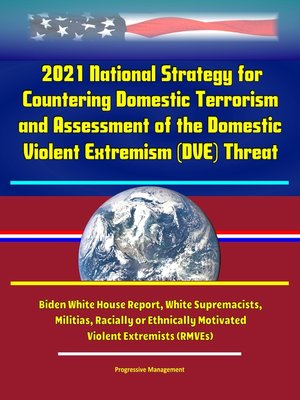2021 National Strategy for Countering Domestic Terrorism and Assessment of the Domestic Violent Extremism (DVE) Threat--Biden White House Report, White Supremacists, Militias,...
ebook
By Progressive Management

Sign up to save your library
With an OverDrive account, you can save your favorite libraries for at-a-glance information about availability. Find out more about OverDrive accounts.
Find this title in Libby, the library reading app by OverDrive.



Search for a digital library with this title
Title found at these libraries:
| Loading... |
Professionally converted for accurate flowing-text e-book format reproduction, this is a reproduction of the 2021 National Strategy for Countering Domestic Terrorism and Assessment of the Domestic Violent Extremism (DVE) Threat.
Domestic terrorism is not a new threat in the United States. It has, over centuries, taken many American lives and spilled much American blood - especially in communities deliberately and viciously targeted on the basis of hatred and bigotry. After the Civil War, for example, the Ku Klux Klan waged a campaign of terror to intimidate Black voters and their white supporters and deprive them of political power, killing and injuring untold numbers of Americans. The Klan and other white supremacists continued to terrorize Black Americans and other minorities in the decades that followed. In recent years, we have seen a resurgence of this and related threats in one horrific incident after another: the shooting and killing of 23 people at a retail store in El Paso; the vehicular killing of a peaceful protestor in Charlottesville; the shooting and killing of three people at a garlic festival in Gilroy; the arson committed at a mosque in Victoria, Texas; the appalling rise in violence and xenophobia directed against Asian Americans; the surge in anti-Semitism; and more.
Domestic terrorist attacks in the United States also have been committed frequently by those opposing our government institutions. In 1995, in the largest single act of domestic terrorism in U.S. history, an anti-government violent extremist detonated a bomb at the Alfred P. Murrah Federal Building in Oklahoma City, killing 168 people - including 19 children - and injuring hundreds of others. In 2016, an anti-authority violent extremist ambushed, shot, and killed five police officers in Dallas. In 2017, a lone gunman wounded four people at a congressional baseball practice. And just months ago, on January 6, 2021, Americans witnessed an unprecedented attack against a core institution of our democracy: the U.S. Congress.
Domestic terrorism poses a serious and evolving threat. A provision of Federal law defines "domestic terrorism" as "activities that involve acts dangerous to human life that are a violation of the criminal laws of the United States or of any State; appear to be intended to intimidate or coerce a civilian population, to influence the policy of a government by intimidation or coercion, or to affect the conduct of a government by mass destruction, assassination, or kidnapping; and occur primarily within the territorial jurisdiction of the United States." Over time, domestic terrorism threats in the United States have ebbed and flowed, reflected different motivating ideologies, and demanded varying governmental responses. Today's domestic terrorism threat, as assessed comprehensively by America's intelligence and law enforcement professionals in early 2021, involves a complex mix of elements.






